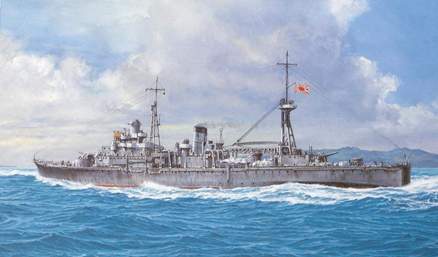HIJMS Hatsutaka
Written by Stephen Burton
discovered 3rd April 2008
Wreck Report & Images Courtesy of Davy Jones Locker, Koh Tao
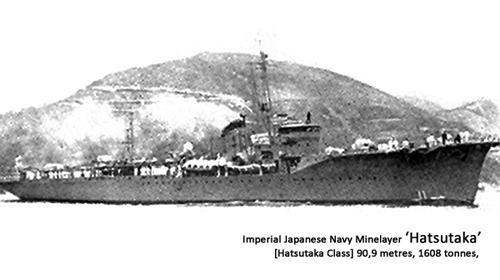
The Japanese Minelayer HIJMS Hatsutaka was completed in October 1939. Built by Harima & Co. Hatsutaka gave it’s name to that class of ship. Measuring 90.9 metres in length with a 11.3 metre beam, the Hatsutaka class had a fast, sleek design displacing 1608 tonnes. Engineered with a dual shaft, three boiler power plant, 6000hp was delivered to the propellers giving the minelayer a maximum speed of 20 knots.
The Hatsutaka class were dual purpose minelayers and net tenders.
With a capacity 360 mines, at the time of building HIJMS Hatsutaka was armed with four 40 mm guns plus a further four 25mm anti aircraft guns.
As WW2 progressed, American submarines become increasingly effective in disrupting Japanese shipping, reducing the transport of vital raw materials. In response, HIJMS Hatsutaka was modified and assigned the role of convoy escort, in an effort to restore the flow of aggregates for the Japanese war machine. Hatsutaka excelled in this new role. Fiercely defending Japanese marus throughout the Gulf of Thailand and Malaysian peninsular, Hatsutaka rapidly became the scourge of US Submarines in this area.
On May 3rd 1945, Japanese Naval records show that the Hatsutaka attacked a submarine in the southern Gulf of Thailand, dropping depth charges on the submerged vessel at 30 fathoms. It’s believed that this was the Baleo Class submarine USS Lagarto [SS-371]. All 86 men on the USS Largato were lost.
Written by Tim Lawrence, Gary Bain & Darius Moazzami
| Introduction
Throughout the Second World War, the Gulf of Thailand and Malaysian peninsular was the scene for much naval conflict, with the loss of many military and cargo vessels. The relatively shallow depth throughout this region means through the application of deep technical diving techniques, we can explore the seabed, revisiting these lost ships and investigating history. During March 2008, a team of divers from Davy Jones Locker [Koh Tao, Thailand], organised an expedition to locate and identify a military vessel with a lot of history in this region – the Imperial Japanese Navy Minelayer Hatsutaka. Here are our findings. |
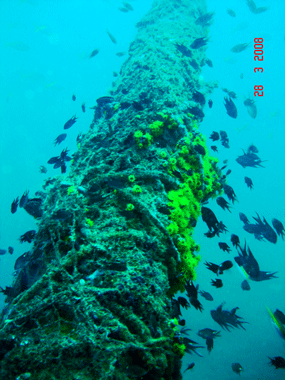
Image: Mast on the forward section of the HIJMS Hatsutaka |
Historical Perspective
The Japanese Minelayer HIJMS Hatsutaka was completed in October 1939. Built by Harima & Co. Hatsutaka gave it’s name to that class of ship. Measuring 90.9 metres in length with a 11.3 metre beam, the Hatsutaka class had a fast, sleek design displacing 1608 tonnes. Engineered with a dual shaft, three boiler power plant, 6000hp was delivered to the propellers giving the minelayer a maximum speed of 20 knots.
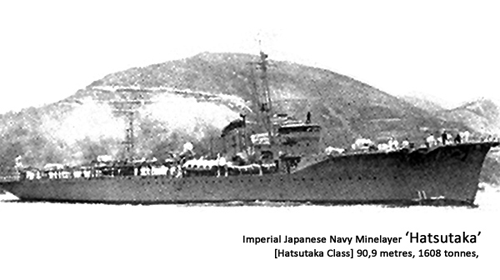
Image: WW2 Minelayer HIJMS Hatsutaka
The Hatsutaka class were dual purpose minelayers and net tenders.
With a capacity 360 mines, at the time of building HIJMS Hatsutaka was armed with four 40 mm guns plus a further four 25mm anti aircraft guns.
As WW2 progressed, American submarines become increasingly effective in disrupting Japanese shipping, reducing the transport of vital raw materials. In response, HIJMS Hatsutaka was modified and assigned the role of convoy escort, in an effort to restore the flow of aggregates for the Japanese war machine. Hatsutaka excelled in this new role. Fiercely defending Japanese marus throughout the Gulf of Thailand and Malaysian peninsular, Hatsutaka rapidly became the scourge of US Submarines in this area.
On May 3rd 1945, Japanese Naval records show that the Hatsutaka attacked a submarine in the southern Gulf of Thailand, dropping depth charges on the submerged vessel at 30 fathoms. It’s believed that this was the Baleo Class submarine USS Lagarto [SS-371]. All 86 men on the USS Largato were lost.
Commanding Officer of USS Lagarto, Commander Latta was a veteran of war, having previously made seven patrols as Commanding Officer of USS Narwhal II (SS-167). Every patrol made by this officer was designated successful for the award of combat insignia, a record surpassed by no commanding officer in the Submarine Force.
USS Hawkbill [SS-366] Commanding Officer, Lt. Comdr. F. W. Scanland, Jr. was a close friend of Commander Latta. Stationed in peninsular Malaysia, when the Lagarto was reported overdue, he swore to avenge the loss of his colleagues.

Image: Baleo class submarine USS Hawkbill, photographed in October 1945 [Courtesy of http://usshawkbill.com/366/]
This excerpt is from the Official History of the USS Hawkbill [http://usshawkbill.com/366/].
“Continued westward and at two o’clock in the morning, 16 May, commenced patrolling in shallow water seven miles off the Malay coast, just north of Pulo Tenggol, Malaya, scene of much of Hawkbill’s later actions.
Within two hours after arrival on station, and 2 hours before dawn, Hawkbill contacted an unidentified target running south along the coast. Within an hour after contact, after closing to get at the target before he could enter a mined area behind Pulo Tenggol, Hawkbill had fired six torpedoes from the forward nest for two hits. Range was 2600 yards. Target stopped and opened up with a barrage of four-inch and automatic weapons fire which lasted off and on until seven o’clock in the morning. The target was obviously hurt, but still afloat, and his gunfire held Hawkbill off during darkness.
Pulling clear until dawn, Hawkbill submerged and started back in, closing sufficiently to identify the target as a sleek, fast mine layer of the Hatsutaka Class. He was being towed slowly toward the beach, stern first., by a small sea truck of about 400 tons. At extreme range of 4650 yards, Hawkbill fired a second salvo of three torpedoes at this target. Sighting the wakes, Hatsutaka opened fire with everything he had in an effort to detonate the torpedoes. To no avail, however, for one broke him in two with a terrific explosion amidships.”
Davy Jones Locker Dive Expedition: March 28th 2008, Eastern Peninsular Malaysia
After researching war reports and cross referencing this data against local knowledge, we determined the likely location of HIJMS Hatsutaka. Malaysian fishermen were aware of a large wreck in their waters, and suggested it was from the correct period, but were unaware of the identity.
We believed the wreck would be situated several kilometers north of Dungun, to the north-west of Pulao Tenngol, approximately one kilometer off shore. This is a popular spot for the fishermen to drop fish traps, and for spear fishing.
With the logistical assistance of local Tenngol Island dive operator Lee Tong Theng ‘Charlie’, we chartered a fishing boat and headed to the wreck site, with the objective of locating and identifying the Hatsutaka. Scheduled during one of South East Asia’s inter-monsoon periods, the expedition was coordinated to coincide with the best possible diving conditions. A large river estuary flows into the sea at Dungun, but we would be diving sufficiently far north for visibility to remain unaffected.

Image: DJL Diving PADI Course Director Darius Moazzami prepares to dive
Arriving early morning with near zero wave heights, we ran a brief sonar survey, before deploying the shot line. Maximum depth in this area is relatively shallow at 35m, but the region does suffer strong north-south currents.
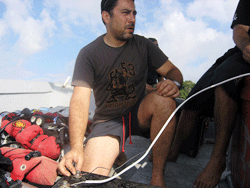
Image: Manolo tends to the depth sonar
We planned five waves of wreck dives throughout the day, breaking into teams of two divers so we could discuss the observations from each dive and maximize the effectiveness of our survey. Visibility was in the 10-15m range, with the current running strong in the morning then easing off later in the day.
On the first dive our shot line was secured to what we believe to be the forward section of the wreck. The ship is broken in two main portions, with the break situated amidships rear of the bridge.
The bow section is lying on it’s port side, measuring approximately 45m in length. This forward section lies on a roughly north-south orientation.
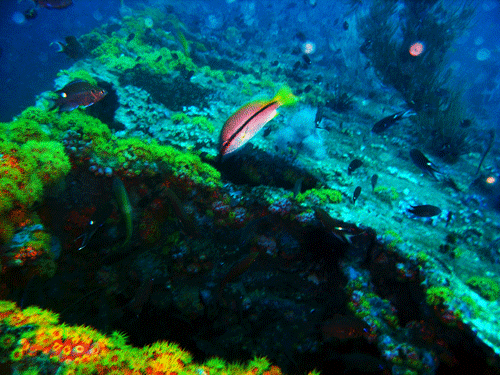
Image: Forward section of the WW2 Minelayer HIJMS Hatsutaka
The stern section of the wreck is sitting upright on the seabed, approximately 25m off the bow section, extending west, towards the mainland. The structure is still mostly solid, with portholes lining the hull. This is all consistent with the information given in the original war report, with Hatsutaka being towed stern first towards the mainland, and breaking in two.
In addition to the two main sections, there are other scattered areas of wreckage. Primarily attributable to the original torpedo attack, this is has also been contributed to by ‘dynamite fishing’ which was only made illegal and enforced by the marine police as recently as ten years ago.
The wreck is rich with WW2 artifacts. In the debris field beneath the bridge, we observed typical WW2 Japanese naval items.
Of particular interest was part of a pair of binoculars, which are characteristic of the superior optics used by the Japanese at this time.


Left image: Part of a set of binoculars, typical of Japanese optics used in WW2
Right Image: Gyroscopic compass and range finding device
This artifact is very similar to a set recovered from the Japanese Heavy Cruiser Haguro [sunk 55 miles south west of Penang, Malaysia].
Also fascinating, was a large gyroscopic ship’s compass and range finding instrument, fitted with intricate glass prisms and scales.
After cleaning the coral of the top piece of the range-finder, we found the following manufacturers plate:
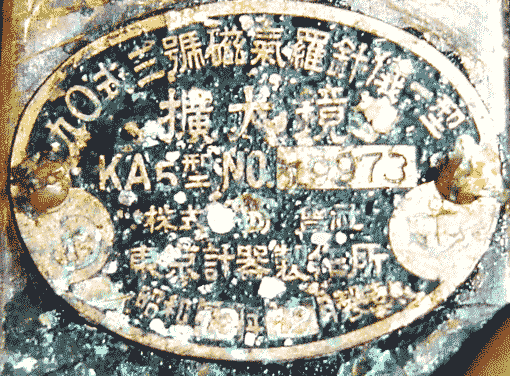
Image: Makers plate on top of range-finding device
The translation of the Japanese script, comes out as follows:
90 Compass Type 1
[Kou-Dai-Kyo] Big Mirror
Type KA5 No. 19973
Company Name
Tokyo Keiki Sei Sakujo [Tokyo measurement company]
Made December 1938
Given that the HIJMS Hatsutaka was completed in 1939, the date of the makers stamp on the compass fits well.
Scattered across the wreck we saw several pressure sensitive mechanisms which we assume to be part of a depth charge triggering mechanism. These are stamped with Japanese script.

Image: Depth charge detonator device
On the stern section there are many unexploded shells.
We recovered an empty casing, which measured 25mm, again consistent with the technical details for HIJMS Hatsutaka.
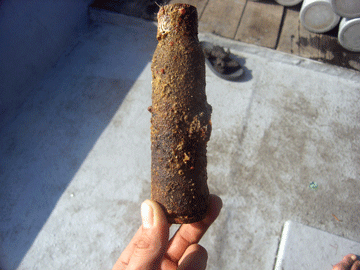
Image: 25 mm casing, consitent with HIJMS Hatsutaka’s armament
We also observed what we assume to be an anti aircraft turret mounting, and believe the gun to has fallen off the mounting, into the wreckage.
After 63 years on the seabed, the wreck of HIJMS Hatsutaka is now rich with marine life. The ship is encrusted with colorful corals, with an enormous population of fusiliers and trevelly surrounding the wreck, a testament to nature’s ability to overcome adversity.
Diving the Hatsutaka was a fascinating experience, and we’ll soon return with another team of divers from Davy Jones Locker to further explore and map the wreck.
Original Standardized wreck report follows
- VESSEL_NAME: HIJMS Hatsutaka
- VESSEL_NATIONALITY: Japanese
- TYPE_OF_VESSEL: Minelayer
- DEPTH_WRECK: 30
- DEPTH_SEABED: 35
- LOCATION: NW of Puluo Tenngol, Peninsular Malsysia
- GPS_NORTH: UNKNOWN
- GPS_EAST: UNKNOWN
- WRECK_LENGTH: 90.9
- WRECK_WIDTH: 11.3
- WRECK_TONS: 1608
- WRECK_PROPS: 2
- BOTTOM_CONDITION: Sand
- SENDER_EMAIL: [email protected]
- SENDER_DIVESHOP_EMAIL: [email protected]
- SENDER_DIVESHOP_URL: http://www.techdivethailand.com
- authorisation_code: 78726329
- SUBMIT_KEY: Submit
- Remote Name: 118.173.232.16
- Remote User:
- HTTP User Agent: Mozilla/4.0 (compatible; MSIE 7.0; Windows NT 5.1;
- InfoPath.2)
- Date: Saturday, April 05, 2008
- Time: 12:37:47 AM
- HOW_WRECK_SUNK:
This excerpt is from the Official History of the USS Hawkbill [http://usshawkbill.com/366/].
“Continued westward and at two o’clock in the morning, 16 May, commenced patrolling in shallow water seven miles off the Malay coast, just north of Pulo Tenggol, Malaya, scene of much of Hawkbill’s later actions.
Within two hours after arrival on station, and 2 hours before dawn, Hawkbill contacted an unidentified target running south along the coast. Within an hour after contact, after closing to get at the target before he could enter a mined area behind Pulo Tenggol, Hawkbill had fired six torpedoes from the forward nest for two hits. Range was 2600 yards. Target stopped and opened up with a barrage of four-inch and automatic weapons fire which lasted off and on until seven o’clock in the morning. The target was obviously hurt, but still afloat, and his gunfire held Hawkbill off during darkness.
Pulling clear until dawn, Hawkbill submerged and started back in, closing sufficiently to identify the target as a sleek, fast mine layer of the Hatsutaka Class. He was being towed slowly toward the beach, stern first., by a small sea truck of about 400 tons. At extreme range of 4650 yards, Hawkbill fired a second salvo of three torpedoes at this target. Sighting the wakes, Hatsutaka opened fire with everything he had in an effort to detonate the torpedoes. To no avail, however, for one broke him in two with a terrific explosion amidships.”
- WRECK_DOING_WHAT:
As WW2 progressed, American submarines become increasingly effective in disrupting Japanese shipping, reducing the transport of vital raw materials.
In response, HIJMS Hatsutaka was modified and assigned the role of convoy escort, in an effort to restore the flow of aggregates for the Japanese war machine. Hatsutaka excelled in this new role. Fiercely defending Japanese marus throughout the Gulf of Thailand and Malaysian peninsular, Hatsutaka rapidly became the scourge of US Submarines in this area.
On May 3rd 1945, Japanese Naval records show that the Hatsutaka attacked a submarine in the southern Gulf of Thailand, dropping depth charges on the submerged vessel at 30 fathoms. It’s believed that this was the Baleo Class submarine USS Lagarto [SS-371]. All 86 men on the USS Largato were lost.
Commanding Officer of USS Lagarto, Commander Latta was a veteran of war, having previously made seven patrols as Commanding Officer of USS Narwhal II (SS-167). Every patrol made by this officer was designated successful for the award of combat insignia, a record surpassed by no commanding officer in the Submarine Force.
USS Hawkbill [SS-366] Commanding Officer, Lt. Comdr. F. W. Scanland, Jr. was a close friend of Commander Latta. Stationed in peninsular Malaysia, when the Lagarto was reported overdue, he swore to avenge the loss of his colleagues.
- OTHER_INFORMATION:
The bow section is lying on it’s port side, measuring approximately 45m in length. This forward section lies on a roughly north-south orientation.
The stern section of the wreck is sitting upright on the seabed, approximately 25m off the bow section, extending west, towards the mainland.
The structure is still mostly solid, with portholes lining the hull. This is all consistent with the information given in the original war report, with Hatsutaka being towed stern first towards the mainland, and breaking in two.
In addition to the two main sections, there are other scattered areas of wreckage. Primarily attributable to the original torpedo attack, this is has also been contributed to by ‘dynamite fishing’ which was only made illegal and enforced by the marine police as recently as ten years ago.
The wreck is rich with WW2 artifacts. In the debris field beneath the bridge, we observed typical WW2 Japanese naval items.
Of particular interest was part of a pair of binoculars, which are characteristic of the superior optics used by the Japanese at this time.
Also fascinating, was a large gyroscopic ship’s compass and range finding instrument, fitted with intricate glass prisms and scales.
Scattered across the wreck we saw several pressure sensitive mechanisms which we assume to be part of a depth charge triggering mechanism. These are stamped with Japanese script.
On the stern section there are many unexploded shells.
We recovered an empty casing, which measured 25mm, again consistent with the technical details for HIJMS Hatsutaka.
We also observed what we assume to be an anti aircraft turret mounting, and believe the gun to has fallen off the mounting, into the wreckage.
After 63 years on the seabed, the wreck of HIJMS Hatsutaka is now rich with marine life. The ship is encrusted with colorful corals, with an enormous population of fusiliers and trevelly surrounding the wreck, a testament to nature’s ability to overcome adversity.
- DIVE_TEAM_NAME_EMAILS:
[Davy Jones’ Locker Koh Tao] Gary Bain, Tim Lawrence, Darius Moazzami, Tristan Termat, Manuel Santana Lopez [ [email protected] ]
DJL Diving | Koh Tao, Thailand
PADI 5* GOLD PALM Resort [s-36338]
BSAC Centre of Excellence [No.484]
tel [+66] 77 456 604
fax [+66] 77 456 303
